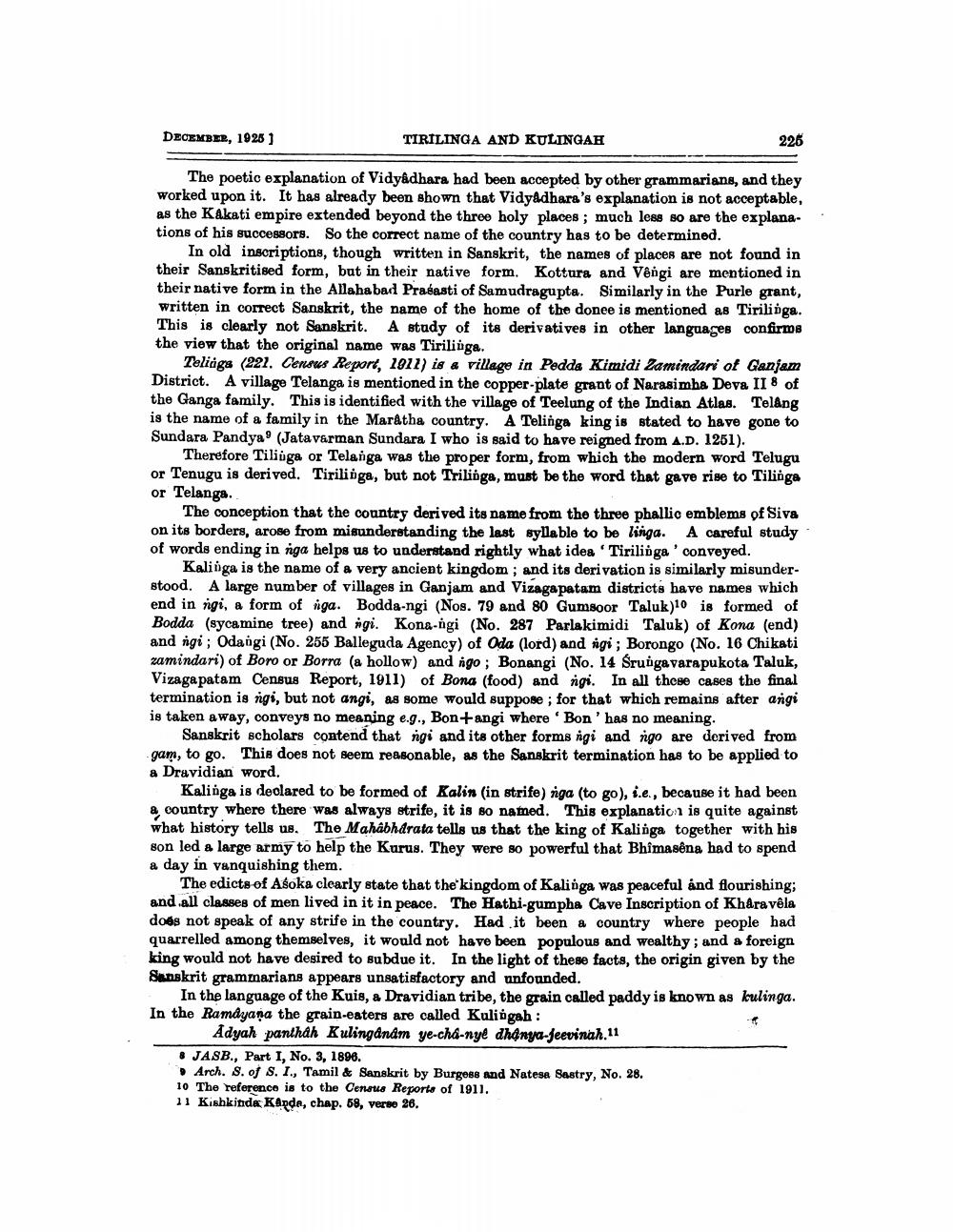________________
DECEMBER, 1926 1
TIRILINGA AND KULINGAH
228
The poetic explanation of Vidyadhara had been accepted by other grammarians, and they worked upon it. It has already been shown that Vidyadhara's explanation is not acceptable, as the Kakati empire extended beyond the three holy places; much less so are the explanations of his successors. So the correct name of the country has to be determined.
In old inscriptions, though written in Sanskrit, the names of places are not found in their Sanskritised form, but in their native form. Kottura and Vengi are mentioned in their native form in the Allahabad Prasasti of Samudragupta. Similarly in the Purle grant, written in correct Sanskrit, the name of the home of the donee is mentioned as Tiriliiga. This is clearly not Sanskrit. A study of its derivatives in other languages confirms the view that the original name was Tiriliiga.
Teliaga (221. Census Report, 1912) is & village in Pedda Kimidi Zamindari of Ganjam District. A village Telanga is mentioned in the copper-plate grant of Narasimha Deva II 8 of the Ganga family. This is identified with the village of Teelung of the Indian Atlas. Telâng is the name of a family in the Maratha country. A Telinga king is stated to have gone to Sundara Pandya (Jatavarman Sundara I who is said to have reigned from A.D. 1251).
Therefore Tilinga or Telanga was the proper form, from which the modern word Telugu or Tenugu is derived. Tirilinga, but not Triliiga, must be the word that gave rise to Tilinga or Telanga.
The conception that the country derived its name from the three phallic emblems of Siva on its borders, arose from misunderstanding the last syllable to be linga. A careful study of words ending in nga helps us to understand rightly what idea 'Tirilióga 'conveyed.
Kalinga is the name of a very ancient kingdom; and its derivation is similarly misunderstood. A large number of villages in Ganjam and Vizaga patam districts have names which end in ngi, a form of iga. Bodda-ngi (Nos. 79 and 80 Gumsoor Taluk)10 is formed of Bodda (sycamine tree) and ngi. Kona-ngi (No. 287 Parlakimidi Taluk) of Kona (end) and ngi; Odangi (No. 256 Balleguda Agency) of Oda (lord) and igi; Borongo (No. 16 Chikati zamindari) of Boro or Borra (a hollow) and ngo; Bonangi (No. 14 Srungavarapukota Taluk, Vizaga patam Census Report, 1911) of Bona (food) and nigi. In all these cases the final termination is rigi, but not angi, as some would suppose ; for that which remains after angi is taken away, conveys no meaning e.g., Bontangi where 'Bon' has no meaning.
Sanskrit scholars contend that ngi and its other forms igi and rigo are derived from gam, to go. This does not seem reasonable, as the Sanskrit termination has to be applied to a Dravidian word.
Kalinga is declared to be formed of Kalin (in strife) riga (to go), i.e., because it had been & country where there was always strife, it is so named. This explanation is quite against what history tells us. The Mahabharata tells us that the king of Kalinga together with his son led a large army to help the Kurus. They were so powerful that Bhimasena had to spend a day in vanquishing them.
The edicts of Asoka clearly state that the kingdom of Kalinga was peaceful and flourishing; and all classes of men lived in it in peace. The Hathi-gumpha Cave Inscription of Khára vêla does not speak of any strife in the country. Had it been a country where people had quarrelled among themselves, it would not have been populous and wealthy; and a foreign king would not have desired to subdue it. In the light of these facts, the origin given by the Sanskrit grammarians appears unsatisfactory and unfounded.
In the language of the Kuis, a Dravidian tribe, the grain called paddy is known as kulinga. In the Ramdyana the grain-eaters are called Kulingah:
Adyah panthah Kulinganam ye-cha-nye dhanya-jeevinah.11 8 JASB., Part I, No. 3, 1896.
Arch. S. of S. I., Tamil & Sanskrit by Burgess And Natesa Sastry, No. 28. 10 The reference is to the Census Reports of 1911. 11 Kishkinda Kapde, chap. 58, verse 26.




